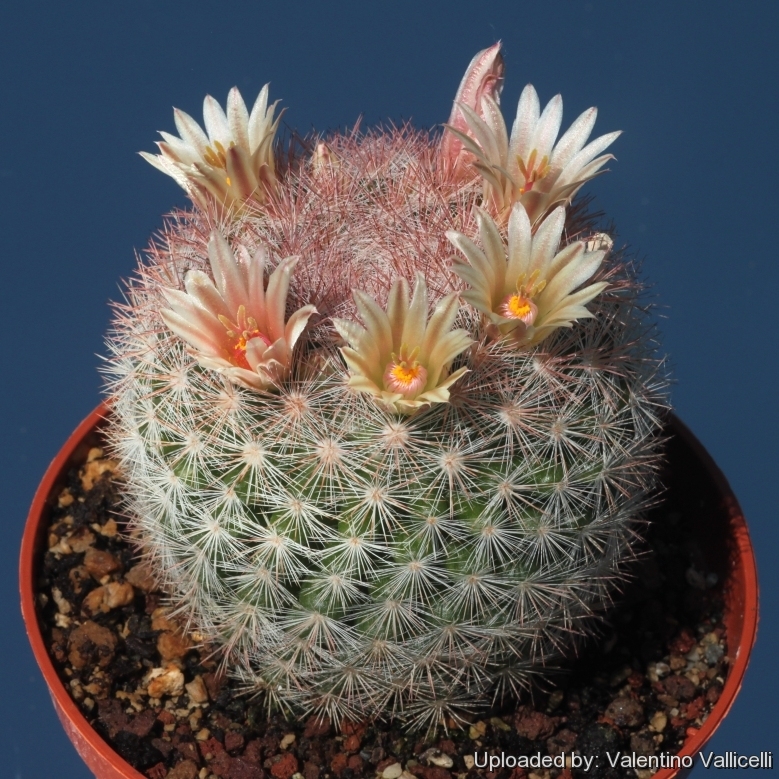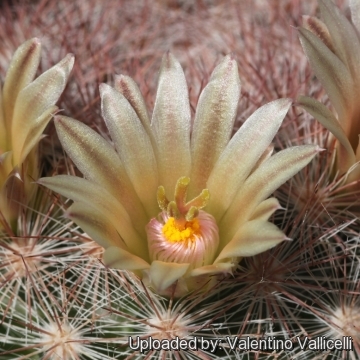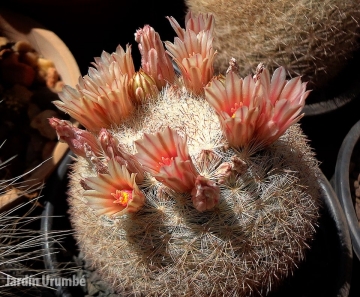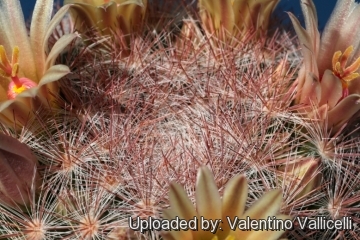= Mammilloydia candida f. rosea (Salm-Dyck) Buxb. in Krainz
Kakteen (H. Krainz) CIV f. 1973 in adnot Krainz
Accepted Scientific Name: Mammilloydia candida (Scheidw.) Buxb.
Oesterr. Bot. Z. 98: 65. 1951

Mammilloydia candida var. rosea (Mammilloydia candida f. rosea) Photo by: Valentino Vallicelli
SB280 (Collector: Steven Brack) Mammillaria candida (f. rosea). Locality Huizache, San Luis Potosi, Mexico.
Origin and Habitat: San Luis Potosi, Mexico.
Synonyms:
See all synonyms of Mammilloydia candida
back
Accepted name in llifle Database:Mammilloydia candida (Scheidw.) Buxb.Oesterr. Bot. Z. 98: 65. 1951Synonymy: 23
back
Description: Mammillaria candidaSN|9015]]SN|9015]] f. rosea was originally described by Salm-Dyck in 1898. It is a nice pink spined form of the usually white Mammillaria candidaSN|9015]]SN|9015]]. Today the names Mammillaria candidaSN|9015]]SN|9015]] var. rosea has been dismissed as a colour variant in a colour variabile species, and is not accepted by many botanists that treat it as synonym, but it still has a value for a collector because they identify plants with particular characters. However in the trade there are different plants labelled simply Mammillaria candidaSN|9015]]SN|9015]] that have central spines, with noticeable pink apex.
Subspecies, varieties, forms and cultivars of plants belonging to the Mammilloydia candida group
 Mammilloydia candida (Scheidw.) Buxb.: has up to 120 radial spines, cylindrical tubercles, 4-7 axillary hairs and rose pink flowers with greenish red midveins. Distribution: oahuila, Guanajuato, Nuevo Leon, San Luis Potosi, and Tamaulipas.
Mammilloydia candida (Scheidw.) Buxb.: has up to 120 radial spines, cylindrical tubercles, 4-7 axillary hairs and rose pink flowers with greenish red midveins. Distribution: oahuila, Guanajuato, Nuevo Leon, San Luis Potosi, and Tamaulipas. Mammilloydia candida subs. ortizrubiona (Bravo) Krainz in Krainz: has fewer radial spines (up to 60), fewer and larger tubercles, long axillary hairs and paler flowers. Distribution: Xichú and Guamúchil, Guanajuato.
Mammilloydia candida subs. ortizrubiona (Bravo) Krainz in Krainz: has fewer radial spines (up to 60), fewer and larger tubercles, long axillary hairs and paler flowers. Distribution: Xichú and Guamúchil, Guanajuato. Mammilloydia candida f. rosea (Salm-Dyck) Buxb. in Krainz: is a colour variant with nice pink tipped spines.
Mammilloydia candida f. rosea (Salm-Dyck) Buxb. in Krainz: is a colour variant with nice pink tipped spines.
Bibliography: Major references and further lectures
1) John Pilbeam “Mammillaria The Cactus File Handbook” Cirio Pub. Services, 01/Dec/1999
2) Edward Anderson “The Cactus family” Timber Press, Incorporated, 2001
3) James Cullen, Sabina G. Knees, H. Suzanne Cubey "The European Garden Flora Flowering Plants: A Manual for the Identification of Plants Cultivated in Europe, Both Out-of-Doors and Under Glass" Cambridge University Press, 11/Aug/2011
4) David R Hunt; Nigel P Taylor; Graham Charles; International Cactaceae Systematics Group. "The New Cactus Lexicon" dh books, 2006
5) Gurcharan Singh Randhawa, Amitabha Mukhopadhyay “Floriculture in India” Allied Publishers, 01/Jan/1986
6) N. L. Britton, J. N. Rose “The Cactaceae. Descriptions and Illustrations of Plants of the Cactus Family.” Volume 4, The Carnegie Institution of Washington, Washington 1923
7) Haustein, E. “Der Kosmos-Kakteen-fuhrer” Balogh Scientific Books, 1998
8) Alfred Byrd Graf “Exotica, series 4 international: pictorial ecyclopedia of exotic plants from tropical and near-tropic regions” Roehrs Co. Publishers, 1982
9) Roger Spencer “Horticultural Flora of South-eastern Australia: Flowering plants. Dicotyledons. Pt. 1” UNSW Press, 01/Jan/1995
10) Fitz Maurice, B, Fitz Maurice, W.A., Hernández, H.M., Sotomayor, M. & Smith, M. 2013. Mammilloydia candida. The IUCN Red List of Threatened Species. Version 2014.3. <www.iucnredlist.org>. Downloaded on 02 May 2015.
 - SB280 Huizache, San Luis Potosi, Mexico. (Mammilloydia candida f. rosea) Photo by: Valentino Vallicelli
- SB280 Huizache, San Luis Potosi, Mexico. (Mammilloydia candida f. rosea) Photo by: Valentino Vallicelli Mammilloydia candida var. rosea (Mammilloydia candida f. rosea) Photo by: Alexander Arzberger
Mammilloydia candida var. rosea (Mammilloydia candida f. rosea) Photo by: Alexander Arzberger SB280 Huizache, San Luis Potosi, Mexico. (Mammilloydia candida f. rosea) Photo by: Valentino Vallicelli
SB280 Huizache, San Luis Potosi, Mexico. (Mammilloydia candida f. rosea) Photo by: Valentino VallicelliSend a photo of this plant.The gallery now contains thousands of pictures, however it is possible to do even more. We are, of course, seeking photos of species not yet shown in the gallery but not only that, we are also looking for better pictures than those already present.
Read More... Cultivation and Propagation: Mammilloydia candidaSN|9012]]SN|9012]] f. rosea is a slow-growing, clustering species that reproduces easily by cutting. It is a great starter plant for the cactus grower, that builds up into a dense cluster of stems brightened by white spines.
Soils: It likes very porous standard cactus mix soil with little organic matter (peat, humus).
Repotting: Repotting every 2-3 years. As it is prone to rot under-pot in a smaller container filled with very porous compost. Use pot with good drainage.
Watering: Water regularly in summer, but do not overwater (very wet-sensitively, especially in light of its succulent root system). Its roots are easily lost in pots that stay damp for any length of time. Keep dry with ample airflow in winter. In the rest period no high atmospheric humidity!! Care must be taken with watering as they tends to become swollen and untidy in growth habit if given too much water and shade.
Fertilization: During the growing season enrich the soil using a fertilizer rich in potassium and phosphorous, but poor in nitrogen, because this chemical element doesn’t help the development of succulent plants, making them too soft and full of water.
Hardiness: It is quite frost resistant if kept dry, hardy as low as -5° C (some reports give it hardy to -12°C). However some warmth throughout the year will increase the grower's success (minimum 5° to 8°C during rest season).
Exposition: Outside bright sun, filtered sunlight or afternoon shade, inside it needs bright light, and some direct sun. Subject to sunburn if exposed to direct sun for too long. Tends to bronze in strong light, which encourages flowering and heavy wool and spine production.
Uses: It is an excellent plant for container growing. It always looks good and stays small. It look fine in a cold greenhouse and frame.
Pests & diseases: It may be attractive to a variety of insects, but plants in good condition should be nearly pest-free, particularly if they are grown in a mineral potting-mix, with good exposure and ventilation. Nonetheless, there are several pests to watch for:
- Red spiders: Sensitive to red spider mite. Overhead watering is helpful in controlling mites.
- Mealy bugs: Occasionally mealy bugs they develop aerial into the new growth among the wool with disfiguring results, but the worst types develop underground on the roots and are invisible except by their effects.
- Scales: Scales are rarely a problem.
- Rot: Rot it is only a minor problem with cacti if the plants are watered and “aired” correctly. If they are not, fungicides won't help all that much.
Propagation: Direct sow after last frost or division . Seeds germinate in 7-14 days at 21-27° C in spring, remove the glass cover gradually as the plants develops and keep ventilated, no full sun for young plants! The seedlings should not be disturbed until they are well rooted, after which they can be planted separately in small pots. Cuttings: wait until the offsets that appear at the base of old clustered specimens are 1/3 the size of the parent and then detach and plant. Cuttings will take root in a minimum temperature of 20° C (but better in hot weather). Cuttings of healthy shoots can be taken in the spring and summer. Cut the stem with a sharp, sterile knife, leave the cutting in a warm, dry place for a week or weeks (depending on how thick the cutting is) until a callus forms over the wound. Once the callus forms, the cutting may be inserted in a container filled with firmed cactus potting mix topped with a surface layer of coarse grit. They should be placed in the coarse grit only; this prevents the cut end from becoming too wet and allows the roots to penetrate the rich compost underneath. The cuttings should root in 2 to 6 weeks.













